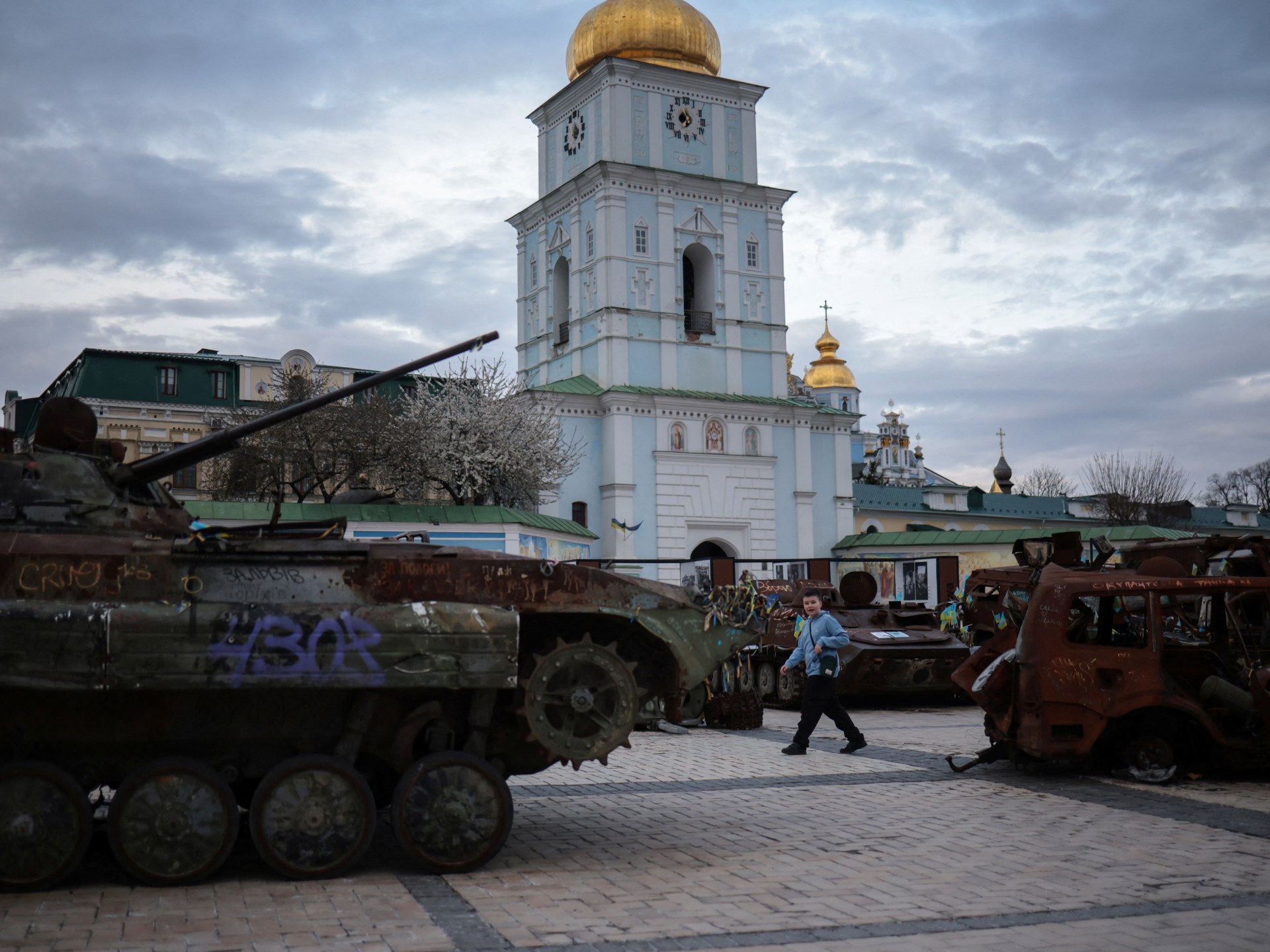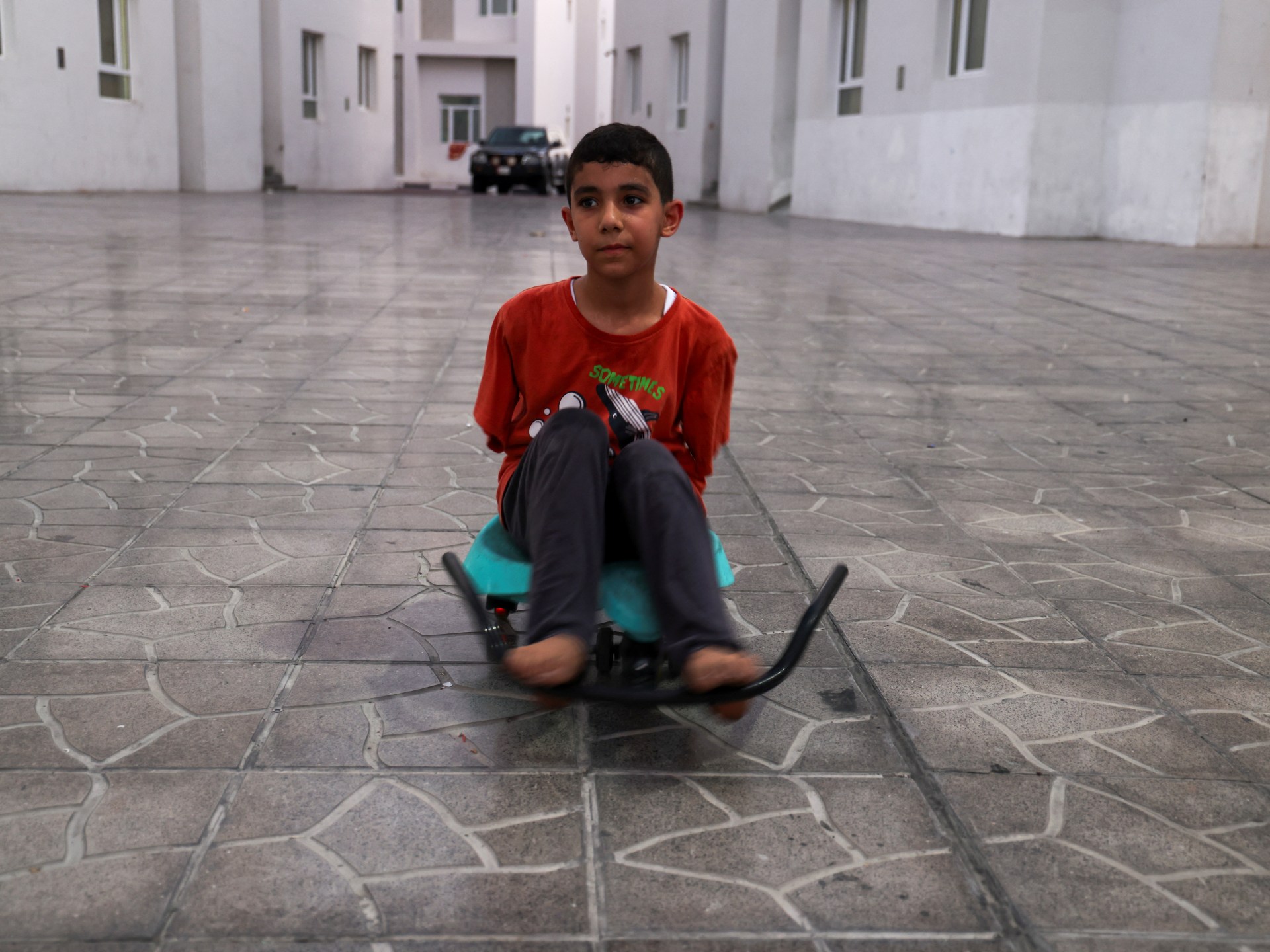Conflict Zones
Chinese soldiers in Ukraine: Is Beijing sending troops to back Russia? | Russia-Ukraine war News

Ukrainian President Volodymyr Zelenskyy said on Tuesday that his military had captured two Chinese men fighting with the Russian army.
Zelenskyy said that this was a clear sign that Russian President Vladimir Putin intended to continue the Ukraine war, potentially threatening the ongoing peace negotiations brokered by US President Donald Trump.
Ukrainian officials also said that the capture of Chinese soldiers – the first such instance in more than three years of the war – raised questions about Beijing’s commitment to peace. China has long insisted that it is a neutral party in the war and has pushed for a ceasefire, even as its relations with Russia have strengthened throughout the war.
Beijing has also, so far, avoided sending weapons and other military equipment for Russia to use in the war, while playing a key role in propping up the Russian economy, battered by unprecedented waves of Western sanctions.
So does the capture of Chinese soldiers in Ukraine, if confirmed, suggest that Beijing is now changing its policy and getting more directly involved in the war, including with manpower support for Russia?
What happened?
Zelenskyy posted on X, saying two Chinese citizens were captured by the Ukrainian military in Ukraine’s Donetsk region. Russia occupied parts of Donetsk alongside other Ukrainian provinces in 2022. Zelenskyy wrote that the army found identification documents, bank cards and “personal data” in the possession of the captured Chinese citizens.
“We have information suggesting that there are many more Chinese citizens in the occupier’s units than just these two,” Zelenskyy wrote. He added that Kyiv is continuing investigations into the matter and has contacted Beijing for a response. The captured men are currently in the custody of the Security Service of Ukraine, according to Zelenskyy.
“Russia’s involvement of China, along with other countries, whether directly or indirectly, in this war in Europe is a clear signal that Putin intends to do anything but end the war,” Zelenskyy wrote, adding, “This definitely requires a response. A response from the United States, Europe, and all those around the world who want peace.”
Ukrainian Minister of Foreign Affairs Andrii Sybiha said this casts a shadow of doubt on China’s formal position advocating for peace. “Chinese citizens fighting as part of Russia’s invasion army in Ukraine puts into question China’s declared stance for peace and undermines Beijing’s credibility as a responsible permanent member of the UN Security Council,” Sybiha wrote in an X post on Tuesday.
Our military has captured two Chinese citizens who were fighting as part of the Russian army. This happened on Ukrainian territory—in the Donetsk region. Identification documents, bank cards, and personal data were found in their possession.
We have information suggesting that… pic.twitter.com/ekBr6hCkQL
— Volodymyr Zelenskyy / Володимир Зеленський (@ZelenskyyUa) April 8, 2025
How has China responded?
China has denied Zelenskyy’s claims that several Chinese nationals are fighting in the war.
“Such claims have no basis. In fact, China’s position on Ukraine is very clear,” Chinese Foreign Ministry spokesperson Lin Jian told reporters in Beijing on Wednesday.
“Ukrainian side needs to view correctly China’s efforts and constructive role for the political settlement of the crisis.”
Are there past reports of Chinese soldiers fighting in Ukraine?
Yes, news outlets and social media posts have previously said that Chinese mercenaries are fighting in Ukraine.
French news outlet Le Monde reported on April 6 that it identified social media accounts of 40 Chinese people who claim to have signed up with Russian forces. The outlet interviewed a 37-year-old Chinese man who joined the war as a foreign mercenary in July 2023 and has since moved back to China.
In October 2024, there were reports on social media that Ukrainian forces had killed two Chinese mercenaries in Russia, the US-based Newsweek magazine reported. However, this was not backed by evidence and could not be independently verified by Newsweek.
Is China sending its soldiers to fight for Russia?
No, even if Zelenskyy is right and Chinese nationals are fighting in Ukraine on Russia’s behalf, that does not imply that Beijing has sent them there.
Mercenaries from multiple countries have arrived in Russia as tourists and joined the army in fighting against Ukraine. Several foreign mercenaries have also fought on Ukraine’s side against Russia in the war. And many foreign nationals have claimed over the past three years that they were duped into joining the Russian or Ukrainian militaries after being promised other jobs – a lucrative pay packet an incentive.
What other foreign fighters are involved in the Russia-Ukraine war?
In 2022, Putin supported a plan to allow foreign fighters to join Russia in the war. Many South Asian men, predominantly from Nepal, India and Sri Lanka, joined as mercenaries seeking economic opportunities.
While a Nepali Ministry of Foreign Affairs official estimated that about 200 Nepali men were fighting in Russia by the end of 2023, many estimate that there might be thousands of Nepalis on the battlefield.
In February, the Indian Ministry of External Affairs said that 127 Indian nationals were serving in the Russian armed forces. It is unclear how many among these Indian nationals are still fighting in Russia. According to the ministry last month, 16 Indian nationals who were serving in the Russian army have gone missing and the Indian government is in contact with the Russian government to find them.
South Korea, the US and Ukraine have also alleged that North Korean troops are fighting alongside Russian soldiers in Kursk amid strengthening military cooperation between Moscow and Pyongyang. Russia has not explicitly confirmed this. “But there is a difference: the North Koreans were fighting on the Kursk front against us,” Zelenskyy said on Tuesday during a combined briefing with Belgian Prime Minister Bart De Wever. “The Chinese are fighting on the territory of Ukraine,” said Zelenskyy.
Meanwhile, Colombia-based City Paper Bogota reported in November 2024 that more than 300 Colombian mercenaries fighting on Ukraine’s side had been killed during the war. Some Sri Lankans and Indians have also fought on Ukraine’s side.
Western nationals have also joined the war, fighting on the Ukrainian side. Many of these volunteer soldiers are US nationals. It is unknown how many US nationals are currently fighting in Ukraine. A CNN investigation published in January revealed that 20 Americans are missing in action in Ukraine, and casualties are spiking.
What is China’s stance on the Ukraine war?
China officially claims a neutral stance on the war. Beijing says it does not provide Russia or Ukraine with lethal assistance, unlike Western countries which have armed Kyiv with cutting-edge weapons.
“China welcomes all efforts aimed at promoting peace talks and supports the establishment of a balanced, effective, and sustainable European security framework to ultimately achieve lasting peace and stability in Europe,” Chinese Foreign Minister Wang Yi said in February.
However, China is a close political and economic ally of Russia and has continued to purchase discounted Russian oil, which has helped fund Moscow amid economic sanctions from the West.
Western companies withdrew business from Russia following Moscow’s full-scale invasion of Kyiv in February 2022. However, Chinese companies, including tech giants Alibaba and DiDi, continued business in Russia without scaling back. Chinese exports to Russia grew to fill the vacuum left behind by Western companies. In October 2024, Chinese exports to Russia grew by 12.7 percent compared with the previous year, Chinese customs data showed.
China has also backed Russia in United Nations resolutions on the war. In February, China abstained from voting on a UN General Assembly (UNGA) resolution which called for “advancing a comprehensive, just and lasting peace in Ukraine”. In February 2023, China abstained from voting on a UNGA resolution calling on Moscow to withdraw its troops from Ukraine. In April 2022, China voted against a UNGA resolution suspending Russia from the UN Human Rights Council.
What is the latest on Russia-Ukraine peace talks?
Since February, teams from Russia and Ukraine have separately met with representatives from the US for peace talks in Saudi Arabia. On March 25, the US and Russia announced a Black Sea deal where Russia agreed to halt the use of force and stop the military use of commercial vessels in the Black Sea. Ukraine agreed to these terms. All sides also agreed to a 30-day ceasefire on attacks on Russian and Ukrainian energy infrastructure.
However, Russia and Ukraine have since traded blame for violating the agreed terms so far. Putin also has not agreed to a 30-day complete ceasefire jointly greenlit by Washington and Kyiv.
On April 6, Zelenskyy posted on X, saying: “Today’s Russian attack included missiles launched from the waters of the Black Sea … A ceasefire at sea is not just about free navigation and the export of food products — it is, above all, about overall security and bringing peace closer.”
Conflict Zones
Could an earthquake shift the balance in Myanmar’s civil war? | Military News
Bangkok, Thailand – As Myanmar slowly recovers from the magnitude 7.7 earthquake that killed thousands in March, an even greater catastrophe continues to shape the nation’s future – this one man-made.
Myanmar remains gripped by a civil war and after four years of fighting the military regime finds itself increasingly encircled.
But the impact of the earthquake could prove decisive for the conflict in the coming year.
Striking in Myanmar’s central Sagaing Region on March 28, the quake killed at least 3,649 people, with more than 5,000 injured and 145 still missing, according to figures from the military government.
The seismic shock flattened houses, factories, Buddhist pagodas, apartment blocks and brought down bridges and ripped up roads in Sagaing city and nearby Mandalay.
It also disrupted electricity supplies to factories producing munitions for the military, said Tin Lin Aung, a former major in Myanmar’s army who defected to the resistance movement in 2022.
In a clear sign that military supplies are stretched, bullet and artillery casings recently captured from government forces bear this year’s manufacturing date, Tin Lin Aung said.
“When I was in the military, we used to joke that some of the bullets were older than us,” he said.
“Now they are being used straight away,” he said.
The reported interruption to the military’s ammunition production comes as areas the army still controls in Myanmar are surrounded on almost all sides by longstanding ethnic armed groups and newer armed opposition forces.
Despite this, the military maintains an iron grip on the country’s major cities and core critical infrastructure.
Hemmed into urban strongholds, the military has tried to reverse its losses through indiscriminate air strikes and burning villages in rural areas – a campaign the United Nations suspects involves war crimes.

‘More momentum than the military’
Sagaing city was devastated by the quake and it remains under military control, while much of the surrounding countryside is governed by a patchwork of resistance militias – such as the People’s Defence Force (PDF) – which are loosely coordinated by the opposition National Unity Government (NUG).
The NUG declared a truce in earthquake-affected areas until April 20, except for “defensive operations”, yet the military’s operations have continued.
According to the NUG, the Myanmar military’s aerial and artillery attacks killed at least 72 civilians between the quake striking on March 28 until April 8. Two more civilians, including a 13-year-old girl, died from bombing by military aircraft on April 10, the Myanmar Now news outlet reports.
A Sagaing-based PDF fighter who requested anonymity said some rebel units had pivoted to relief efforts in central Myanmar even though their military adversaries were taking advantage of the lull in battle.
“Since the quake, the military has used the Sagaing-Monywa road more confidently because of the truce,” she said. But PDF forces in Sagaing expect fighting to intensify after the April truce is over.
“The PDF has more momentum than the military here,” she told Al Jazeera, adding that the NUG is now “coordinating better with ethnic armed organisations”.
“There will be more fighting in coming months,” said Ko Ko Gyi of the Sagaing PDF’s Battalion 3.
Regional security analyst Anthony Davis said he doubted the earthquake would distract the military from its strategic objectives, adding that most soldiers had stayed in their garrisons rather than help with relief efforts.
“The military isn’t taking time off to save people. They’ll keep up the air strikes and, where possible, launch ground offensives to weaken the PDF,” Davis said.
But it is western Rakhine State – largely spared from the earthquake – that is still the most consequential battleground currently, he said.
There, the rebel Arakan Army (AA) has clashed with the military’s forces around the state capital Sittwe and Kyaukphyu, the site of a key pipeline that transports gas from across Myanmar to China.
The AA has simultaneously pushed out of its home territory in the west of the country and into Myanmar’s central heartlands in Magwe, Bago and Ayeyarwady regions, Davis said.
“They are the swing player who can significantly move this conflict one way or another,” he added.
Commanding an estimated 40,000 soldiers, the AA has a proven record of defeating the military regime’s forces.
In eastern Myanmar’s Kayah State, a senior resistance commander said the earthquake had underscored the suffering of displaced communities who “bear the brunt of the ongoing wars”.
“The side who’s willing to care for the people can sway public opinion and will succeed in the coming battles,” he said.
In the north and northwest, the military is on the back foot.
The Kachin Independence Army captured Indaw town in the northern Sagaing Region on April 7 after an eight-month siege, despite declaring its own post-quake truce. Chin resistance forces recently gained control of Falam township in western Myanmar – though they had not announced any ceasefire.
Political analyst Kyaw Hsan Hlaing said the military is still grappling with the aftermath of the earthquake and that may create openings for the AA and others to seize more towns.
“However, any such gains would likely be incremental, as the military’s longstanding control and ability to adapt, especially in regions like Bago and Magwe, even under crisis conditions remain significant,” he said.
“In the long term, the earthquake is unlikely to fundamentally shift the balance of power in Myanmar,” he said.
‘Divine intervention’
While the earthquake has not dealt a decisive blow to military rule, the quake has delivered a psychic shock to the regime’s generals.
In a country where astrology and superstition guide the highest political decisions, many interpret the natural disaster as a cosmic rebuke against Myanmar’s military leadership.
“They see this earthquake as divine intervention – punishment for the mistakes of the king. From what I hear, they are not blaming him [regime leader Min Aung Hlaing] directly. But there are questions about his leadership and capacity,” said former major Tin Lin Aung, who still maintains contacts within the secretive military establishment.
According to Tin Lin Aung, the regime has ordered civil servants nationwide to recite a protective Buddhist chant nine times daily for nine consecutive days. The number nine has auspicious symbolism in Buddhist tradition.
He also described growing confusion within the ranks over the regime’s response to the earthquake – appealing for international aid and assistance, declaring a truce, while also continuing its attacks.
“They know the people hate them more and more, and their leader seems lost,” he said.
Richard Horsey, senior Myanmar adviser at the International Crisis Group, said even if Myanmar military’s commander-in-chief Senior General Min Aung Hlaing dismisses these supernatural interpretations, the fact that his inner circle takes them seriously creates real vulnerability. Instead of causing an internal coup, he suggested the quake as a bad omen would more likely signal the erosion of Min Aung Hlaing’s authority and the rise of open criticism.
“You go from there to people feeling they can just ignore his orders and do their own thing because everyone else agrees with them, not him,” he said.
Political analyst Kyaw Hsan Hlaing said some sources suggest that beliefs in the quake as a portent of collapse for military rule may be used to push the narrative that the regime needs to “act decisively to regain control”.
Superstition is just one of many factors shaping the military’s decisions in the conflict, he added.
The earthquake has also “done enormous damage to the basic fabric of Myanmar,” Horsey said, noting that Mandalay’s residents are potentially facing relocation due to extensive housing damage.
Given the scale of the quake, it would likely affect the civil war – “but in ways that are hard to predict”, he said.

Criticised for its ineffectual and disinterested response to earthquake victims, along with continued attacks at a time of national emergency, the military’s poor reputation has plummeted even further in the eyes of the people and its adversaries.
The powerful ethnic armed groups involved in the conflict will probably be even more unwilling to negotiate for peace with the military following the quake, Horsey said.
“Even if you could get a spirit of compromise, which seems not to exist”, few would believe the military’s sincerity in adhering to any peace deal or ceasefire document.
“Who would believe that piece of paper,” Horsey said, when it is signed by a military that is considered “so illegitimate and so incompetent.”
Conflict Zones
Trump says US may ‘pass’ on helping end war if Russia, Ukraine resist deal | Russia-Ukraine war News

President Donald Trump says the United States will “take a pass” on trying to resolve the Russia-Ukraine war if either Moscow or Kyiv makes it too difficult to end the conflict.
Trump was speaking after US Secretary of State Marco Rubio commented – following talks with European allies in Paris – that Washington would “move on” if a truce did not seem “doable” within days.
The US president refused on Friday to cast blame on either Russian President Vladimir Putin, who ordered the February 2022 full-scale invasion of pro-Western Ukraine, or Ukrainian President Volodymyr Zelenskyy. But he insisted both sides had to make progress.
“Now, if, for some reason, one of the two parties makes it very difficult, we’re just going to say: ‘You’re foolish. You’re fools. You’re horrible people’ – and we’re going to just take a pass,” Trump said.
“But, hopefully, we won’t have to do that.”
Rubio further suggested on Friday that Trump’s patience towards the negotiations is running thin.
“If it’s not possible, if we’re so far apart that this is not going to happen, then I think the president is probably at a point where he’s going to say, ‘Well, we’re done,’” he said.
Trump told reporters on Friday, however, that he did not want to say he was walking away from the talks. He said he still believes there is a good chance to end the conflict.
“It’s coming to a head right now,” he said.
US Vice President JD Vance also said he was “optimistic” a resolution could be reached, while speaking on a trip to Rome.
‘Trying to help’
Ukraine has agreed to a full temporary ceasefire and accused Russia of stalling on a deal to get a better negotiating position.
Putin last month rejected a joint US-Ukrainian proposal for a full and unconditional pause in the conflict, while the Kremlin has made a truce in the Black Sea conditional on the West lifting certain sanctions.
When asked if Putin was stalling, Trump, who held direct talks with the Russian leader in February, said: “I hope not … I’ll let you know soon.”
Trump also denied he was being “played” by the former KGB agent, who denied Russia was going to invade right up until the eve of the attack.
“Nobody’s playing me, I’m trying to help,” Trump said.
Russia’s Foreign Minister Sergey Lavrov said in an interview with the Kommersant newspaper published on Monday that it is “not easy” to agree on “key components” of a peace deal.
He did, however, concede that the Trump administration is trying to understand the “root cause” of the conflict, which he said was triggered by “the actions of Washington and Brussels” in having “brought the current regime to power in Ukraine”.
Fighting continues
Amid ceasefire negotiations, on the front line on Friday, a Russian missile strike killed one person in the northeastern Ukrainian city of Kharkiv, with a separate drone attack killing another person in the nearby city of Sumy.
At least five children were among dozens of people injured in Friday morning’s attack on Kharkiv that damaged 15 residential buildings, a business and an educational facility, according to Kharkiv Mayor Ihor Terekhov and emergency services.
Reporting from Kyiv, Al Jazeera’s Zein Basravi said Russia also targeted Lviv, Dnipro, Mykolaiv and Kyiv.
“We saw multiple missile, drone, artillery and rocket attacks in cities across the country about 5am local time when curfews come to a close and people begin their daily lives,” he said.
“[In Kharkiv], civilian infrastructure was damaged, one person was killed, and 74 were injured. Of the 74, five were children,” Basravi reported.
President Zelenskyy said on Thursday that although Russia had seemingly scaled back its targeting of energy infrastructure, the overall volume of missile and drone attacks remained unchanged. It is striking Ukraine’s civilian sites instead, he added.
Russia has said it had hit “key drone production sites” and Ukrainian military airfields.
Moscow also warned on Friday of potential escalation if Germany proceeds with plans to send Taurus long-range missiles to Ukraine. Speaking at the United Nations on Thursday, Russia’s ambassador, Vassily Nebenzia, declared that such a move would mark Germany’s direct entry into the war.
“These countries are waging a war against Russia using their proxy forces,” he said. “Delivering Taurus missiles would be another step toward escalation.”
Conflict Zones
‘How do I live like this?’ asks Gaza boy who lost arms in Israeli attack | Gaza News

An image of Mahmoud Ajjour, 9, who was severely wounded in an Israeli strike, won the 2025 World Press Photo of the Year award.
A Palestinian child who was severely wounded in an Israeli drone attack on Gaza last year, and who was pictured in an image that won the 2025 World Press Photo of the Year award, says he has been struggling to adapt to life since losing both his arms in the explosion.
Speaking to Al Jazeera from Doha, Qatar, where he has been receiving treatment, nine-year-old Mahmoud Ajjour recalled the moment the bomb exploded, targeting his home in March 2024.
At first, Ajjour, who hails from Gaza City’s old town, said he did not realise he was wounded.
“I thought I had simply fallen. But I found myself on the ground, exhausted, and wondering what had happened,” he told Al Jazeera.
In reality, one arm “flew off, and one flew and fell right beside me”, he added.
Still unaware that he had sustained serious wounds – wounds that mutilated his entire body – Ajjour said he looked around and saw his arms. Although they looked familiar, his brain still could not comprehend that they had been blown off.
“My mother then told me that I lost my arms,” Ajjour recalled. “I started crying. I was very sad, and my mental state was very bad.”
His mental health deteriorated further when he, like many others in Gaza, had to undergo surgery without anaesthetics due to a severe lack of medical supplies. Throughout the war, Israeli forces have largely kept vital border crossings shut, preventing the entry of much-needed medical supplies, as well as food and other aid, including fuel.
“They performed surgery on me while I was awake,” Ajjour said, the shock still evident in his voice.
“I couldn’t bear the pain, I was screaming very loud. My voice filled the hallways.”
‘Everything is difficult’
Ajjour is one of thousands of children in Gaza who are suffering life-changing injuries due to relentless, indiscriminate Israeli bombardment.
According to the United Nations Children’s Fund, more than 10 children each day have lost one or both of their legs since October 7, 2023, when Israel launched its ongoing genocide in Gaza.
That is more than 1,000 children.
“Gaza now has the highest number of children amputees per capita anywhere in the world – many losing limbs and undergoing surgeries without even anaesthesia,” UN Secretary-General Antonio Guterres said in December.
Ajjour is now learning to write, play games on his phone, and dress himself using his feet – but still needs special assistance for most daily activities.

He now longs for the days when his arms were still intact.
Before the attack, Ajjour said he used to go to the market and buy his mother vegetables and food she needed.
“Now, everything is difficult, including feeding myself, helping myself to the bathroom … but I try my best,” he said. “I manage my life like this. I make it work.”
Ajjour dreams of a future where he can return to Gaza and help rebuild the devastated enclave.
He hopes the world can “end the war on Gaza”.
“We want to live on our land. We don’t want the Israelis to take it,” he said.
“People are dying there [in Gaza]. And my home was bombed. How could I live like this?”
Israel’s ongoing assault on the besieged and bombarded territory has so far killed more than 51,000 Palestinians and wounded at least 116,505 others, according to Gaza’s Ministry of Health.
It has also forcibly displaced most of its 2.3 million strong population, ravaged most of the land, damaged basic infrastructure and dismantled its already-struggling healthcare system.
-

 Conflict Zones2 days ago
Conflict Zones2 days agoHaiti in ‘free fall’ as violence escalates, rights group warns | Armed Groups News
-

 Lifestyle2 days ago
Lifestyle2 days agoBelievers say microdosing psychedelics helps them. Scientists are trying to measure the claims
-

 Sports2 days ago
Sports2 days agoJu Wenjun: Chinese grandmaster makes history by winning fifth Women’s World Chess Championship
-

 Lifestyle2 days ago
Lifestyle2 days agoPicking a team from bars to beam and hoping for 10s: Fantasy leagues in gymnastics are a thing
-

 Middle East2 days ago
Middle East2 days agoPalestinian photographer Samar Abu Elouf wins world’s top photo prize | Gaza News
-

 Sports2 days ago
Sports2 days agoMajor League Fishing: Three people dead following boating crash on Lewis Smith Lake
-

 Sports2 days ago
Sports2 days agoArsenal reaches first Champions League semifinal in 16 years, with Inter Milan also advancing
-

 Africa2 days ago
Africa2 days agoEuropean Union announces new asylum measures



